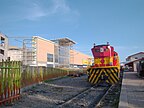
Back وانكاشو Arabic وانكاشو ARZ Wankayu Aymara Huankayo (Peru) Azerbaijani Гуанкаё Byelorussian Уанкаё BE-X-OLD Уанкайо Bulgarian Huancayo Catalan Huancayo (kapital sa rehiyon) CEB Huancayo Czech
Huancayo | |
|---|---|
| Santísima Trinidad de Huancayo Holy Trinity of Huancayo | |
Plaza Constitución, Cathedral of Huancayo, Real Plaza Huancayo, Wanka Identity Park, Administration and Government Pavilion of the National University of the Center of Peru and Panoramic. | |
| Nickname(s): "La Ciudad Incontrastable" (The Uncontrastable City) | |
| Coordinates: 12°4′S 75°13′W / 12.067°S 75.217°W | |
| Country | Peru |
| Region | Junin |
| Province | Huancayo |
| District | Huancayo |
| Founded | 1 June 1572 |
| Government | |
| • Type | Municipal government |
| • Mayor | Henry López Cantorín |
| Area | |
• Total | 319.41 km2 (123.32 sq mi) |
| Elevation | 3,259 m (10,692 ft) |
| Population (2017) | |
• Total | 456,250 |
• Estimate (2015)[1] | 364,725 |
| • Density | 1,400/km2 (3,700/sq mi) |
| Time zone | UTC-5 (PET) |
| • Summer (DST) | UTC-5 (PET) |
| Area code | 64 |
| Website | www.munihuancayo.gob.pe |
Huancayo (Spanish pronunciation: [waŋˈkaʝo]; in Wanka Quechua: Wankayu [wɐŋˈkæjuː], '(place) with a (sacred) rock') is the capital of the Junín Region and Huancayo Province, in the central highlands of Peru, in the Mantaro Valley and is crossed by the Shullcas, Chilca and Mantaro rivers. It was founded as a reduction by the name Santísima Trinidad de Huancayo on 1 June 1572, by Don Jerónimo de Silva, a Spanish conquistador.[2] It is the fifth largest city in Peru, with a population of 500,000 and is among the highest cities in Peru, with an altitude of 3,256 meters (10,692 feet) above sea level. It is considered the economic and social center of central Peru
The Huanca people largely inhabited the area even before the Inca Empire at around 500 BC.[3] They would later form the so-called Huanca kingdom.They were incorporated into the Inca Empire, becoming a stopping point along the Qhapaq Ñan, the section that runs through the city, which today is called Calle Real. Upon the arrival of the Spanish conquistadors notably Francisco Pizarro, the Huancas became faithful and staunch allies, participating in the capture of Cusco and the battles against the Incas of Vilcabamba.[4]
- ^ Perú: Población estimada al 30 de junio y tasa de crecimiento de las ciudades capitales, por departamento, 2011 y 2015. Perú: Estimaciones y proyecciones de población total por sexo de las principales ciudades, 2012-2015 (Report). Instituto Nacional de Estadística e Informática. March 2012. Retrieved 3 June 2015.
- ^ "1 de Junio: Fundación de la ciudad de Huancayo". noticias.laiglesiadejesucristo.org (in Spanish). 1 June 2019. Retrieved 16 January 2024.
- ^ Keatinge, Richard W. (10 March 1988). Peruvian Prehistory: An Overview of Pre-Inca and Inca Society. Cambridge University Press. ISBN 978-0-521-27555-2.
- ^ Cartwright, Mark (4 May 2014). "Wanka Civilization". World History Encyclopedia. Retrieved 16 January 2024.









